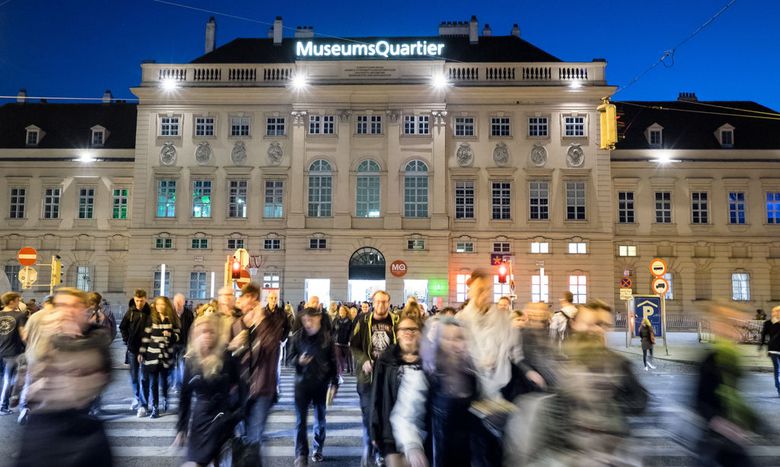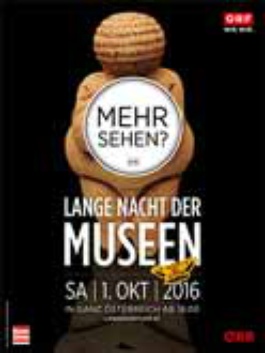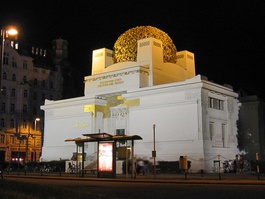
MUSEUMS BY STARLIGHT
Published on
The Long Night of the Museums allows visitors to enjoy hundreds of Austrian museums and cultural attractions into the early hours.
The first Saturday of October has meant one thing in Austria for the past 17 years. Lange Nacht Der Museen, the Long Night of the Museums. Around 700 of Austria's museums open their doors until one in the morning and one ticket offers visitors access to as many of them as they like.
This year around 360,000 people used the opportunity to visit museums, galleries and cultural institutions all over the country. The most popular attraction proved to be the Naturhistorisches Museum in Vienna which saw 11,400 visitors pass through its splendidly gilded doors, perhaps hoping to catch a glimpse of the famous Venus of Willendorf, one of the oldest known prehistoric statues in the world and an important artefact for our understanding of early mankind. In Vienna alone, 134 institutions held events, from traditional galleries such as the world famous Albertina, Leopold and Belvedere to museums such as the previously mentioned natural history museum and the Sigmund Freud museum. Other more quirky museums participated in the festivities, such as the Funeral Services Museum, the Condomi museum (that's right, a museum to condoms) and more innocently perhaps, a museum dedicated to snow globes.
 The event was however not only confined to the capital. Institutions across Austria opened their doors and welcomed visitors late into the night. I myself can testify to the fact that this event reaches all parts of the country. Two years ago I found myself being shown around a quaint yet fascinating town museum in Burgenland, not far from the border with Hungary. Though, whilst the museum itself was very interesting, the party that continued late into the night in the basement was unforgettable. Hearing a man sing 'Hey Jude' in a strong Burgenland accent is something that I will never be able to get out of my head. That night went a long way towards forming the love I have for this country.
The event was however not only confined to the capital. Institutions across Austria opened their doors and welcomed visitors late into the night. I myself can testify to the fact that this event reaches all parts of the country. Two years ago I found myself being shown around a quaint yet fascinating town museum in Burgenland, not far from the border with Hungary. Though, whilst the museum itself was very interesting, the party that continued late into the night in the basement was unforgettable. Hearing a man sing 'Hey Jude' in a strong Burgenland accent is something that I will never be able to get out of my head. That night went a long way towards forming the love I have for this country.
This year the experience was not quite the same in Vienna. However that is not a reflection on the level of enjoyment. €16 or €12 for concessions bought you a ticket to access the 134 participating Viennese institutions. So armed with this golden ticket I set of.
I managed four museums in total, starting at the Secession exhibition space, the epicentre of cultural change in the early twentieth century. The golden domed building is an icon of the movement and was originally used to display the works of painters and sculptors such as Gustav Klimt, Joseph Hoffmann and Max Kurzweil. A highlight of the building is the remains of the Beethoven Frieze by Klimt, from the group's 14th exhibition dedicted to the composer. The main exhibition space is currently dedicated to the Berlin based, Georgian born artist Thea Djordjadze. Djordjadze has relocated her studio to the gallery and arranged it in the exhibition space, creating a vast instillation which seems to reflect the freedom of an artist's creativity. Whilst being an impressive building and a thought provoking series of exhibits, the space itself is not one for an art novice. In terms of bein informative there was not a great amount on offer, and could therefore be off putting for some who previously would not have visited the gallery, which seems at odds with the overall philosophy of the event.
 The next museum I took in was the Mozart Wohnung, the apartment in the centre of Vienna where the renowned composer spent his most productive two years. Whilst being limited on the amount of artefacts that belonged to Mozart the house did contain items from his time and did explain a lot about the artists life and work and gave the visitor an impression of what the home-life of the composer must have been like, for example the relationship he had with his wife and children as well as that with his father and other composers, such as his friendship with another great Austrian composer, Joseph Haydn.
The next museum I took in was the Mozart Wohnung, the apartment in the centre of Vienna where the renowned composer spent his most productive two years. Whilst being limited on the amount of artefacts that belonged to Mozart the house did contain items from his time and did explain a lot about the artists life and work and gave the visitor an impression of what the home-life of the composer must have been like, for example the relationship he had with his wife and children as well as that with his father and other composers, such as his friendship with another great Austrian composer, Joseph Haydn.
A short U-Bahn ride brought me to the second half of my experience. The Kunsthistorisches Museum houses masterpieces from many of the great masters of European art. The building itself is something of a masterpiece, with its elaborate cornicing and vibrant gilding and marble floors and staircases, which glittered in the light, lending an elegant feel to the building. This sense of elegance was highlighted even further by the orchestra playing at the top of the staircase near the balcony.
The art works themselves did not have quite the same magnitude as other great European galleries such as the Louvre, National Gallery or Prado nor maybe other Viennese galleries such as the Albertina or Leopold, it did however provide the distinction between Northern and Southern European art from the Renaissance to the Baroque, the highlights of which being Van der Weyden's Crucifixion triptych and Caravaggio's depiction of Christ being crowned with thorns. On the first floor the exhibition of Eqyption art and Roman sculpture also displays the development of western art and civilization in a clear and concise way.
A short walk across from the museum and past the statue to Empress Maria Theresa who gives her name to the square in which both museums sit is the Naturhistorisches Museum. The outside of this museum mirrors its sibling in design, though does not quite have the same level of splendour inside.
On the first floor we are confronted with row upon row of mineral samples, with very little explanation as to their purpose, profile or point. Once you have reached the end of the periodic table, about 4 rooms in, the attention is turned to human prehistory. Artefacts and displays explain what life was like for early humans, in particular in Austria and Central Europe. It is in one of these rooms that the Venus of Willendorf sits. At first the statue appears crude, however on further examination the limestone carving is quite deliberate and sophisticated. Despite one passer-by muttering, 'oh, is that it'. It seems as though this prehistoric religious artefact did not strike such a cord with all visitors. Though it has to be said, the museum itself did not have the same level of interactive content as a lot of other modern natural history or science museums, making many of the exhibits appear outdated. The layout of the museum was also quite confusing and did not appear to have been thoroughly planned. For example to reach the section on human evolution there is a section on prehistoric culture. A new layout would perhaps give the exhibition more of a narrative for visitors to follow and help them to more clearly understand human development.
Though, from experience, it appears as though the point of many Viennese museums and galleries is not to inform the many but as a place for those who already have a prior knowledge of the specific subject, artist or era. That coupled with the at times extortionate entry price to many places makes them seem rather exclusive and must be off putting for many people.
The event itself is a well organised and well-oiled machine. In Vienna shuttle buses take visitors to and from museums dotted all over the city. The public service broadcaster behind the event, ORF, televise the event as well as following it on different local radio stations so no region is left out. And whilst some may have qualms with the populist newspaper Kronen Zeitung helping to fund the event, this does allow the ticket price to be low, therefore allowing people who may otherwise not be able to afford the entrance fee to some of the institutions normally, to experience them. And this, surely, must be the ultimate aim of this event, to throw open the doors of such historical and cultural organisations.
The Long Night of the Museum seems to have established itself as a highlight of the Austrian cultural calendar. This year saw its six millionth visitor, perhaps proving its popularity. The first Saturday of October has become an evening when all of Austria can celebrate what the country has to offer and could be an opportunity to show of its history and cultural institutions as well as its unique character to all Austrians as well as new comers to the country, as it did to me in October 2014.



